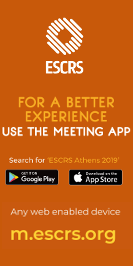Posters
(results will display both Free Papers & Poster)
Regional variation in the administration of fluorescein when performing Goldmann applanation tonometry in the National Health Service, UK
Poster Details
First Author: C.Gunasekera UK
Co Author(s): H. Malik F. Edozie
Abstract Details
Purpose:
Goldmann applanation tonometry (GAT) is generally regarded as the most accurate method to check intraocular pressure in clinical practice. This usually requires the instillation of a local anaesthetic and fluorescein. A combination Minim of Proxymetacaine Hydrochloride 0.5% with Fluorescein Sodium 0.25% used to be the preferred choice, however, this is no longer manufactured in the UK. Since then, several ophthalmologists report the practice of mixing Fluorescein and Proxymetacaine manually in order to recreate this drop to perform GAT. We looked to determine what current practice amongst ophthalmologists in the UK is since the discontinuation of this Proxymetacaine-Fluorescein Minim.
Setting:
The East of England Deanery, National Health Service, UK.
Methods:
A questionnaire designed to determine the practice of instilling fluorescein and local anaesthetic was distributed amongst Ophthalmology departments in the UK within an NHS setting.
Participants were requested to select their preferred technique to perform Goldmann applanation tonometry: by manually mixing Minims fluorescein and Minims proxymetacaine, using Minims lidocaine and fluorescein, using Minims proxymetacaine and a fluorescein strip, or another specified technique. The reason for their preference was also documented.
Results:
8 departments responded to our questionnaire including: Addenbrooke’s Hospital,
Ipswich Hospital, Luton and Dunstable, Moorfield's Eye Hospital, Norfolk and Norwich University Hospital, Southend University, Western Eye Hospital and West Suffolk Hospital.
The majority of participants (75%) perform Goldmann applanation tonometry by mixing proxymetacaine and fluorescein. The reasons stated for manually mixing this medication included: this was the most comfortable method, least painful for patients and the best tolerated (particularly in children).
16.7% of respondents use the lidocaine and fluorescein stating that proxymetacaine and fluorescein was not available.
Conclusions:
Whilst some variation exists in the practice of performing Goldmann applanation tonometry, the majority of departments still perform this by mixing proxymetacaine to fluorescein. The commonest reason sited was to improve comfort to patients. Whilst the combination Minim of proxymetacaine hydrochloride 0.5% with fluorescein sodium 0.25% no longer exists, ophthalmologists continue to manually recreate this to improve comfort to their patients.
Financial Disclosure:
None



